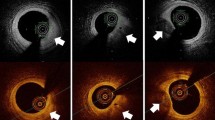Abstract
Optical coherence tomography (OCT) imaging is showing great potential as an alternative or complementary tool to intravascular ultrasound (IVUS) for aiding in stent procedures and future diagnosis/treatment of atherosclerosis. Here, we describe the basic theory behind OCT imaging and explain important parameters such as axial resolution, lateral resolution and sensitivity. Also, we describe several image acquisition techniques that have been adopted for OCT imaging.



Similar content being viewed by others
References
Drexler W, Fujimoto JG (eds) (2008) Optical coherence tomography technology and applications. Springer, Heidelberg
Huang D et al (1991) Optical coherence tomography. Science 254(5035):1178–1181
Fercher AF et al (2003) Optical coherence tomography—principles and applications. Reports Progress Phys 66:239
Bouma BE, Tearney GJ (eds) (2003) Handbook of optical coherence tomography. Marcel Dekker, Inc., New York
Regar E, Serruys PW, Van Leeuwen TG (eds) (2007) Optical coherence tomography in cardiovascular research. Informa Healthcare, London
Tearney GJ et al (1997) In vivo endoscopic optical biopsy with optical coherence tomography. Science 276(5321):2037–2039
Tearney GJ et al (1996) Scanning single-mode fiber optic catheter-endoscope for optical coherence tomography: erratum. Opt Lett 21(12):912
Rollins AM et al (1999) Real-time in vivo imaging of human gastrointestinal ultrastructure by use of endoscopic optical coherence tomography with a novel efficient interferometer design. Opt Lett 24(19):1358–1360
Yun SH et al (2007) Comprehensive volumetric optical microscopy in vivo. Nat Med 12(12):1429–1433
Xi J et al (2009) High-resolution OCT balloon imaging catheter with astigmatism correction. Opt Lett 34(13):1943–1945
Tearney GJ et al (1996) Scanning single-mode fiber optic catheter-endoscope for optical coherence tomography. Opt Lett 21(7):543–545
Brezinski ME et al (1996) Optical coherence tomography for optical biopsy. Properties and demonstration of vascular pathology. Circulation 93(6):1206–1213
Jang IK et al (2002) Visualization of coronary atherosclerotic plaques in patients using optical coherence tomography: comparison with intravascular ultrasound. J Am Coll Cardiol 39(4):604–609
Jang IK, Tearney G, Bouma B (2001) Visualization of tissue prolapse between coronary stent struts by optical coherence tomography: comparison with intravascular ultrasound. Circulation 104(22):2754
Huber R, Wojtkowski M, Fujimoto JG (2006) Fourier Domain Mode Locking (FDML): A new laser operating regime and applications for optical coherence tomography. Opt Express 14(8):3225–3237
Jenkins MW et al (2007) Ultrahigh-speed optical coherence tomography imaging and visualization of the embryonic avian heart using a buffered Fourier Domain Mode Locked laser. Opt Express 15(10):6251–6267
Choma M et al (2003) Sensitivity advantage of swept source and Fourier domain optical coherence tomography. Opt Express 11(18):2183–2189
de Boer JF et al (2003) Improved signal-to-noise ratio in spectral-domain compared with time-domain optical coherence tomography. Opt Lett 28(21):2067–2069
Leitgeb R, Hitzenberger C, Fercher A (2003) Performance of fourier domain vs. time domain optical coherence tomography. Opt Express 11(8):889–894
Fercher AF et al (1995) Measurement of intraocular distances by backscattering spectral interferometry. Opt Commun 117(1–2):43–48
Golubovic B et al (1997) Optical frequency-domain reflectometry using rapid wavelength tuning of a Cr4 + : forsterite laser. Opt Lett 22:1704–1706
Choma MA, Hsu K, Izatt JA (2005) Swept source optical coherence tomography using an all-fiber 1300-nm ring laser source. J Biomed Opt 10(4):44009
Yun S et al (2003) High-speed optical frequency-domain imaging. Opt Express 11(22):2953–2963
Prati F et al (2010) Expert review document on methodology, terminology, and clinical applications of optical coherence tomography: physical principles, methodology of image acquisition, and clinical application for assessment of coronary arteries and atherosclerosis. Eur Heart J 31(4):401–415
Yabushita H et al (2002) Characterization of human atherosclerosis by optical coherence tomography. Circulation 106(13):1640–1645
Kume T et al (2006) Assessment of coronary arterial plaque by optical coherence tomography. Am J Cardiol 97(8):1172–1175
Regar E, Prati F, Serruys PW (2006) Intracoronary OCT application: methodological considerations. In: Van Leeuwen TG, Serruys PW (eds) Handbook of optical coherence tomography. Taylor & Francis Books Ltd, London, pp 53–64
Tanigawa J, Barlis P, Di Mario C (2007) Intravascular optical coherence tomography: optimisation of image acquisition and quantitative assessment of stent strut apposition. EuroIntervention 3(1):128–136
Prati F et al (2008) From bench to bedside: a novel technique of acquiring OCT images. Circ J 72(5):839–843
Prati F et al (2007) Safety and feasibility of a new non-occlusive technique for facilitated intracoronary optical coherence tomography (OCT) acquisition in various clinical and anatomical scenarios. EuroIntervention 3(3):365–370
Tearney GJ et al (2008) Three-dimensional coronary artery microscopy by intracoronary optical frequency domain imaging. JACC Cardiovasc Imaging 1(6):752–761
Imola F, et al. (in press) Safety and feasibility of Frequency Domain- Optical Coherence Tomography to guide decision making in percutaneous coronary intervention. EuroIntervention
Takarada S et al (2010) Advantage of next-generation frequency-domain optical coherence tomography compared with conventional time-domain system in the assessment of coronary lesion. Catheter Cardiovasc Interv 75(2):202–206
Barlis P et al (2009) A multicentre evaluation of the safety of intracoronary optical coherence tomography. EuroIntervention 5(1):90–95
Serruys PW et al (2009) A bioabsorbable everolimus-eluting coronary stent system (ABSORB): 2-year outcomes and results from multiple imaging methods. Lancet 373(9667):897–910
Barlis P et al (2010) Quantitative analysis of intracoronary optical coherence tomography measurements of stent strut apposition and tissue coverage. Int J Cardiol 141(2):151–156
Capodanno D et al (2009) Comparison of optical coherence tomography and intravascular ultrasound for the assessment of in-stent tissue coverage after stent implantation. EuroIntervention 5(5):538–543
von Birgelen C et al (1997) ECG-gated three-dimensional intravascular ultrasound: feasibility and reproducibility of the automated analysis of coronary lumen and atherosclerotic plaque dimensions in humans. Circulation 96(9):2944–2952
Bruining N et al (1998) ECG-gated versus nongated three-dimensional intracoronary ultrasound analysis: implications for volumetric measurements. Cathet Cardiovasc Diagn 43(3):254–260
Yazdanfar S, Kulkarni M, Izatt J (1997) High resolution imaging of in vivo cardiac dynamics using color Doppler optical coherence tomography. Opt Express 1(13):424–431
Chen Z et al (1997) Noninvasive imaging of in vivo blood flow velocity using optical Doppler tomography. Opt Lett 22(14):1119–1121
Conflict of interest
None.
Author information
Authors and Affiliations
Corresponding author
Rights and permissions
About this article
Cite this article
Prati, F., Jenkins, M.W., Di Giorgio, A. et al. Intracoronary optical coherence tomography, basic theory and image acquisition techniques. Int J Cardiovasc Imaging 27, 251–258 (2011). https://doi.org/10.1007/s10554-011-9798-1
Received:
Accepted:
Published:
Issue Date:
DOI: https://doi.org/10.1007/s10554-011-9798-1




